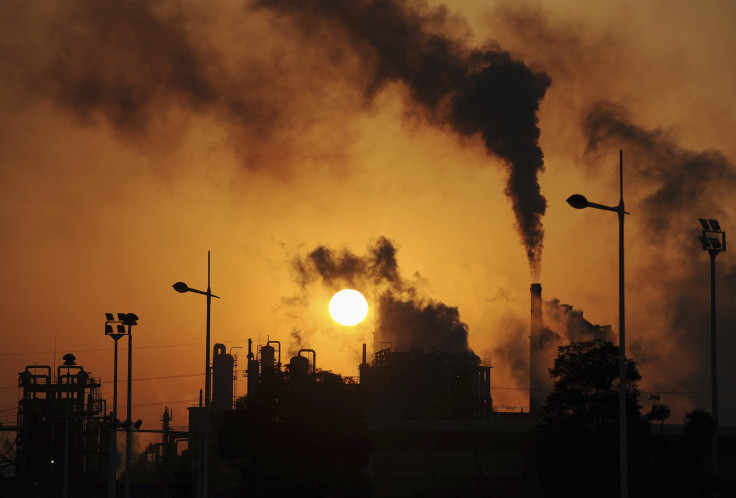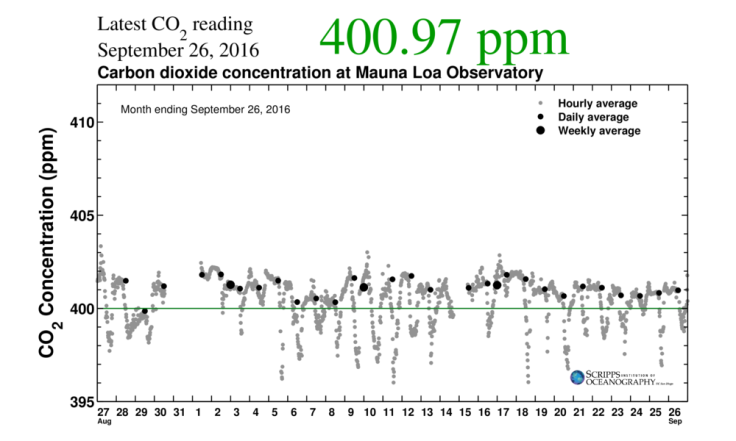Climate Change: Earth’s Atmospheric CO2 Levels Have Permanently Crossed The 400 PPM Red Line

In May 2013, the carbon dioxide monitoring station at Mauna Loa, Hawaii, recorded a major milestone — the concentration of atmospheric carbon dioxide had crossed the symbolic “red line” of 400 parts per million for the first time since record-keeping began. Then, earlier this year, for the first time in 4 million years, carbon dioxide levels at the South Pole passed the threshold of 400 ppm.
Now, scientists at the Mauna Loa Observatory have revealed another sobering finding. This September — usually a month when the atmospheric concentrations of carbon dioxide are at their lowest levels in the northern hemisphere, the level of the greenhouse gas remained stubbornly above the 400 ppm.
This measurement all but ensures that monthly carbon dioxide levels won’t drop below 400 ppm any time in the foreseeable future.

“Is it possible that October 2016 will yield a lower monthly value than September and dip below 400 ppm? Almost impossible. Over the past two decades, there were four years (2002, 2008, 2009, and 2012) in which the monthly value for October was lower than September. But in those years, the decrease from September to October was at most 0.45 ppm — which would not seem to be enough to push October values below 400 ppm this year,” Ralph Keeling, the current program director of the Scripps Institute for Oceanography’s carbon dioxide monitoring program, wrote in a blog post. “The monthly value for October will therefore almost certainly also stay above 400 ppm and probably will be higher than 401 ppm.”
“At best, one might expect a balance in the near term and so CO2 levels probably wouldn't change much — but would start to fall off in a decade or so,” Gavin Schmidt, NASA’s chief climate scientist, told Climate Central via an email. “In my opinion, we won’t ever see a month below 400 ppm.”
This is extremely worrying, especially as it comes close on the heels of a study that extends the global temperature record to two million years in the past, and predicts — somewhat controversially — that the average global temperatures may increase by roughly 5 degrees Celsius (9 degrees Fahrenheit) over the next few millennia, no matter what we do.
“This is not an exact prediction or a forecast,” lead author Carolyn Snyder told Nature. “The experiment we as humans are doing is very different than what we saw in the past.”
Although the predictions made in the study have been met with skepticism, there are certain future scenarios that are generally accepted. One of them is that given the current trajectory of emissions, it is only a matter of time before pre-industrial levels of atmospheric carbon dioxide — approximately 280 parts per million — is doubled. The other is that if this happens, there is nothing that can be realistically done to keep the rise in global temperatures to below 2 degrees Celsius — something that last year’s Paris climate treaty commits to.
Since the Industrial Revolution in the 19th century, the level of atmospheric carbon dioxide has been steadily increasing. The 400 ppm level, while largely symbolic, is a number climate scientists agree is a red line that should never have been crossed, given that it is way higher than the “safe” level of 350 ppm.
© Copyright IBTimes 2024. All rights reserved.






















